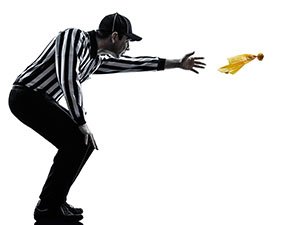Your cart is currently empty!
The Tale of the Yellow Flag: Football’s Most Dramatic Prop

Once upon a time, in the vibrant world of American football, the field was alive with the shouts, grunts, and cheers of players and fans. But there was one small, unassuming hero who played a pivotal role in every game—a hero often misunderstood, yet vital to the sport’s drama and fairness. This hero was none other than the yellow penalty flag.
The Birth of the Yellow Flag
The story of the yellow flag dates back to the 1940s. Before its invention, officials used horns and whistles to signal penalties, often resulting in confusion and missed calls. Enter Dwight “Dike” Beede, a coach and innovator from Youngstown State University. Inspired by the need for clarity, he crafted the first yellow flag from a piece of his wife’s silk dress and some weights. This bright, eye-catching color was chosen to stand out against the green turf and the chaos of the game, ensuring everyone could see when a rule was broken.
The Emotional Rollercoaster
Fast forward to today, and the yellow flag is a well-known symbol of discipline and drama on the field. Imagine a nail-biting, intense game with only seconds left on the clock. The score is tied, and the tension is palpable. Suddenly, a yellow flag soars through the air, spinning like a dramatic exclamation point before landing on the turf. The reactions are instantaneous and intense.
On one side, the player who committed the foul experiences a range of emotions. Initially, there is denial—”No way, that wasn’t me!”—followed by a desperate plea for mercy as they approach the referee with wide eyes and hopeful words. “Come on, ref, it was just a little nudge!” Shame soon follows, a heavy feeling that weighs down their shoulders as they walk back to their position, avoiding the disappointed gazes of their teammates and coaches.
In stark contrast, the opposing team erupts with joy and gloating. “Yeah, that’s right! Take that!” they shout, high-fiving and celebrating their newfound advantage. Their fans join in, taunting the penalized player and cheering louder than ever. The crowd’s reaction is a symphony of boos and cheers, a cacophony that adds to the drama unfolding on the field.
The Psychology Behind the Yellow Flag
But why does this small piece of fabric evoke such strong reactions? The psychology of the yellow flag is fascinating. Yellow is a color that naturally draws attention; it is bright and hard to ignore, often associated with caution and alertness. In the context of football, it signals a break in the action, a pause that demands everyone’s focus.
When a referee throws the flag, it’s not just a signal of a rule broken but also a performance in itself. The way it arcs through the air, the way it lands with authority, it all adds to the spectacle. Players and fans alike are conditioned to respond to this ritualistic act with heightened emotions, their reactions amplified by the color’s association with warning and consequence.
The yellow flag, therefore, is more than just a tool for maintaining order. It is a key player in the psychological game of football, influencing the mindset and emotions of everyone involved. It can change the momentum of a game, shift the crowd’s energy, and alter the strategies of coaches and players.
Conclusion
So next time you watch a football game, keep an eye out for the yellow flag. Remember its humble beginnings and appreciate the crucial role it plays in the sport. It’s not just a piece of fabric—it’s a beacon of fairness, a symbol of the game’s integrity, and a catalyst for some of football’s most memorable moments. And as it flutters down onto the field, it carries with it the weight of history, emotion, and the ever-present drama of the game we all love.
For more intriguing stories and insights into the world of youth sports, visit The Sports Whistle.
References
- “The History of the Yellow Flag,” Football Americana, accessed May 19, 2024.
- “The Psychology of Color in Sports,” Sports Psychology Today, accessed May 19, 2024.
- “Dike Beede: The Innovator Behind the Yellow Flag,” Youngstown State University Archives, accessed May 19, 2024.
Discover more from NuSpeed Network
Subscribe to get the latest posts sent to your email.